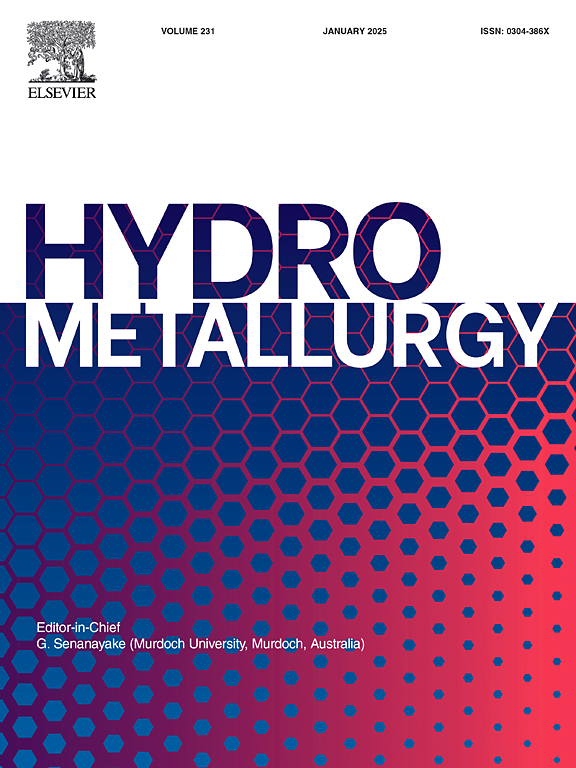The influence of amino acid side chain structure on the leaching behavior of copper from printed circuit boards
IF 4.8
2区 材料科学
Q1 METALLURGY & METALLURGICAL ENGINEERING
引用次数: 0
Abstract
This study evaluated the potential of 15 biological amino acids as eco-friendly lixiviants for copper (Cu) extraction from printed circuit boards (PCBs) under alkaline conditions. The Cu leaching behaviors, complexation mechanisms, and the effect of temperature were examined. The amino acids were classified by their Cu leaching efficiencies: Type-I (Gly, Val, Ala, Arg, His, Lys), Type-II (Pro, Glu, Asp, Thr, Ser), and Type-III (Asn, Gln, Met, Cys). Type-I amino acids achieved >90 % Cu leaching, while Type-II showed moderate dissolution. Type-III formed solid Cu-amino acid complexes as confirmed by XRD and SEM analyses. Increasing temperatures enhanced Cu leaching in both Type-I and Type-II, particularly during the initial stages. Minimal dissolution of aluminum (Al) and iron (Fe) was observed at pH 10–12 and Eh 0–200 mV, allowing for selective Cu dissolution in liquid or solid phases. Aliphatic and polar positively charged amino acids were the most effective due to their ability to form stable bi- and/or tridentate complexes, while carboxyl- and alcohol-containing side chains hindered Cu dissolution. The precipitation of solid Cu-amino acid complexes was attributed to amide and sulfur-containing side chains, as nitrogen, oxygen, and sulfur can form strong coordination bonds with Cu. This is the first study to evaluate the role of amino acid side chain structures in Cu leaching from e-waste and highlights the potential of less commonly studied amino acids in hydrometallurgical applications.
氨基酸侧链结构对印刷电路板中铜浸出行为的影响
本研究评估了15种生物氨基酸作为碱性条件下印制板(pcb)中铜(Cu)提取的环保型浸出剂的潜力。考察了铜的浸出行为、络合机理以及温度的影响。根据其Cu浸出效率将氨基酸分类为:i型(Gly, Val, Ala, Arg, His, Lys), ii型(Pro, Glu, Asp, Thr, Ser)和iii型(Asn, Gln, Met, Cys)。ⅰ型氨基酸铜浸出率达90%,ⅱ型氨基酸铜溶出率中等。通过XRD和SEM分析证实,iii型形成了固体cu -氨基酸配合物。温度升高对ⅰ型和ⅱ型铜浸出均有促进作用,尤其是在初始阶段。在pH 10-12和Eh 0-200 mV条件下,铝(Al)和铁(Fe)的溶解最小,使得Cu在液相或固相中选择性溶解。脂肪族和极性带正电的氨基酸是最有效的,因为它们能够形成稳定的双和/或三叉戟配合物,而羧基和含醇的侧链阻碍了铜的溶解。固体Cu-氨基酸配合物的沉淀归因于酰胺和含硫侧链,因为氮、氧和硫可以与Cu形成强配位键。这是第一个评估氨基酸侧链结构在电子垃圾铜浸出中的作用的研究,并强调了不太常用的氨基酸在湿法冶金应用中的潜力。
本文章由计算机程序翻译,如有差异,请以英文原文为准。
求助全文
约1分钟内获得全文
求助全文
来源期刊

Hydrometallurgy
工程技术-冶金工程
CiteScore
9.50
自引率
6.40%
发文量
144
审稿时长
3.4 months
期刊介绍:
Hydrometallurgy aims to compile studies on novel processes, process design, chemistry, modelling, control, economics and interfaces between unit operations, and to provide a forum for discussions on case histories and operational difficulties.
Topics covered include: leaching of metal values by chemical reagents or bacterial action at ambient or elevated pressures and temperatures; separation of solids from leach liquors; removal of impurities and recovery of metal values by precipitation, ion exchange, solvent extraction, gaseous reduction, cementation, electro-winning and electro-refining; pre-treatment of ores by roasting or chemical treatments such as halogenation or reduction; recycling of reagents and treatment of effluents.
 求助内容:
求助内容: 应助结果提醒方式:
应助结果提醒方式:


